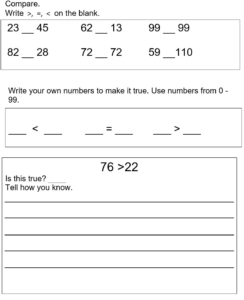MAFS.1.NBT.2.3 Compare two two-digit numbers based on meanings of the tens and ones digits, recording the results of comparisons with the symbols >, =, and <.
Cognitive Complexity Level: 1-Recall
[divider] [/divider] Students are able to…
- Use objects, ten frames, number lines and hundreds charts to compare two-digit numbers
- Describe the comparison using greater than, less than, fewer than and same as
- Use mathematical symbols to compare numbers
[divider] [/divider] Students are able to…because teachers:
- Provide students with a variety of materials to explore comparison of numbers
- Pose purposeful questions to advance understanding of comparing numbers
- Facilitate discussions of student strategies
- Provide experiences to compare numbers when written as numerals and using mathematical symbols
[divider] [/divider] Questions to ask students:
- Ask: Which is greater, 35 or 42? How do you know?
- Sample answer that indicates understanding: I know that 42 is greater because 4 tens is greater than 3 tens.
- Ask: Which is less, 73 or 79? How do you know?
- Sample answer that indicates understanding: I know that 73 is less because the both have 7 tens, but 3 ones is less than 9 ones.
[divider] [/divider] Additional Resources:
Additional in depth content knowledge
Video: Khan Academy – Comparing Numbers
[divider] [/divider] Sample Formative Assessment Tasks:
[divider] [/divider] Resources/Tasks to Support Your Child at Home:
- Give your child two sets of objects from 1 to 100. Encourage them to group the objects by ten and count on by ones to determine total value. Then have your child determine which object there is a greater amount of. Then record the numbers with the symbols <, >, or =.
- Online Video: Compare Numbers First Grade
